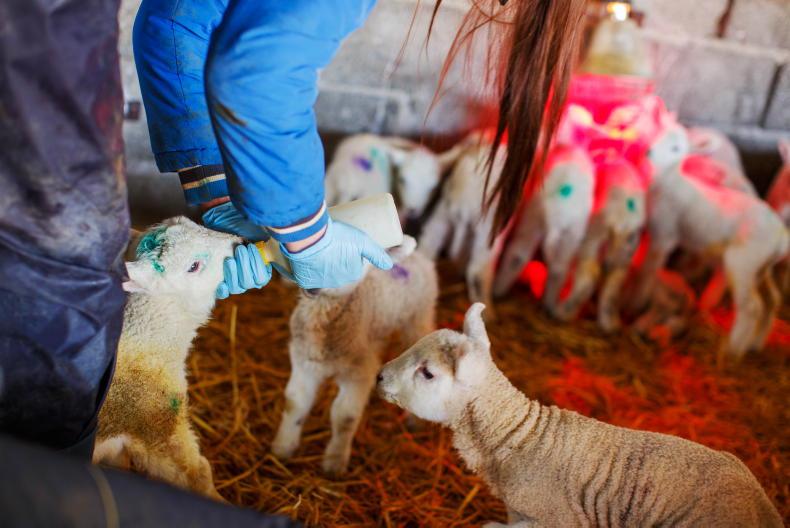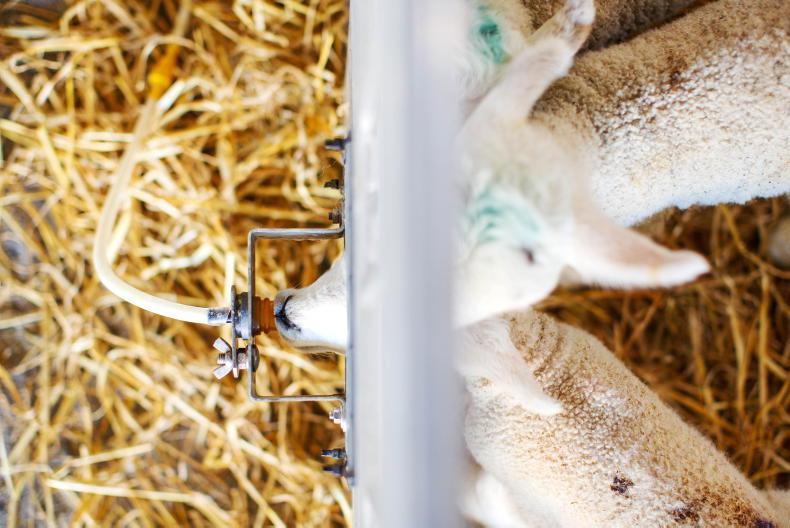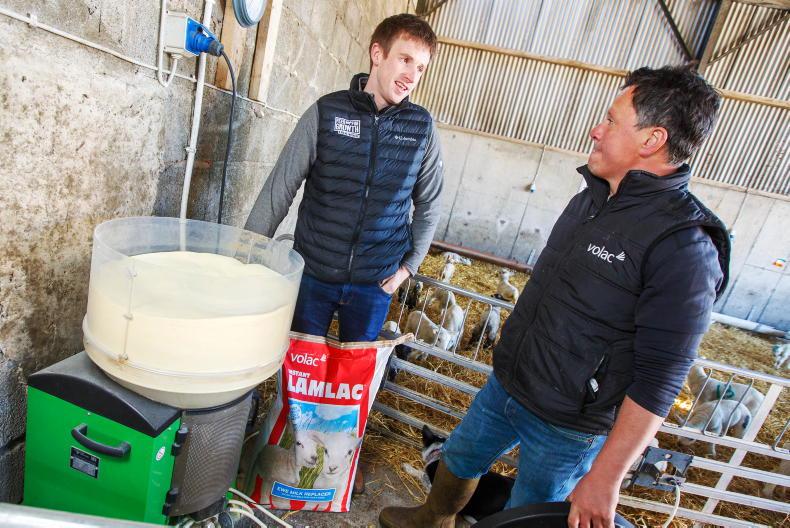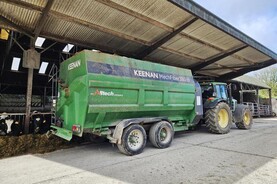John Fagan runs a busy enterprise consisting of 1,200 ewes and 125 beef cattle on a 180-hectare farm in Westmeath.
Managing this number of animals would place a huge demand on any farmer and John is no exception.
During the lambing season, John hires students from Germany and Austria to alleviate the labour pressures at this busy time.
Labour and lambing system
“The extra hands-on during lambing is invaluable and helps maintain a high level of hygiene and lamb care for the spring”, John said.
Lambing season begins in early March and usually finishes around 15 April.
The farm averages 1.7 lambs per ewe. All lambs are kept on the farm for seven months, during which time any surplus lambs are reared on Volac Lamlac milk replacer. The lamb milk replacer is fed through a Volac Förster Technik Eco Lamb Feeder.
John usually rears between 1,600 and 1,700 lambs on the farm, with 180 of these being reared on the automatic feeder.

Extra hands on farm help maintain good hygiene standards during spring.
Feeding
Where possible, lambs are reared on ewes. Once John is happy that the lambs are feeding well off the ewes, they are turned out to grass.
All other lambs receive colostrum before they are moved on to Volac Lamlac milk replacer, fed through a Volac Förster Technik Eco Lamb Feeder.
“I have been using Lamlac for the last 10 years. I find the product extremely reliable and my lambs always thrive on it. I have tried other products over the years, but, in my opinion, nothing compares to it,” said John.
John sees little to no issues in lambs that are reared on Volac Lamlac milk replacer.
When John began using Lamlac, he purchased a Förster-Technik Lamb ECO feeder: “It’s one of the best investments I have ever made on this farm.
"I find it extremely cost efficient and straightforward to operate. It’s easy to train young lambs to feed from the machine and it offers a consistent supply of feed at the optimum temperature, which allows the lambs to thrive quickly,” John said.
All lambs reared on the feeder are fed ad-lib Volac Lamlac milk replacer. In the first few days of life, John gradually introduces a starter ration with hay and builds lambs up to ad lib feeding.

All feeding equipment is sterilised daily on John’s farm.
Lambing shed and hygiene
Cleanliness and hygiene are the foundation to a successful lambing season on this Westmeath farm, explained John.
The first step is to make sure the lambing pens are thoroughly cleaned before the ewes are brought inside to lamb using an appropriate disinfectant.
Once the pen has dried out, John beds it with plenty of clean, dry straw, ready for the new occupants.
“We place a huge emphasis on cleanliness and hygiene in our sheds. We keep the pens bedded with fresh straw and ensure all lambs have access to clean drinking water.
“All feeding equipment used on this farm is sterilised daily. I’m lucky to have enough help here, which allows hygiene practices to be completed regularly,” John said.
Attention to detail when cleaning feeding equipment is also crucial and it’s easily something that can be overlooked when you’re under pressure at lambing time.
But taking the time to disinfect teats, tubes, mixing buckets and other utensils will definitely pay dividends in lamb health.

John receives excellent support from his Volac business manager Tomas O’Reilly.
Volac support
“Over the past few years I have built a really good relationship with my Volac business manager Tomas O’Reilly. Tomas is very approachable and always on hand to offer advice and help when needed, which is very reassuring,” said John.
"I would highly recommend Volac Lamlac lamb milk replacer and the Volac Förster Technik Eco Lamb Feeder to other sheep farmers, especially if you have a large number of surplus lambs,” concluded John.
For further information on Volac Lamlac milk replacer or a Volac Förster Technik Eco Lamb Feeder, contact your local Volac business manager or click here.
John Fagan runs a busy enterprise consisting of 1,200 ewes and 125 beef cattle on a 180-hectare farm in Westmeath.
Managing this number of animals would place a huge demand on any farmer and John is no exception.
During the lambing season, John hires students from Germany and Austria to alleviate the labour pressures at this busy time.
Labour and lambing system
“The extra hands-on during lambing is invaluable and helps maintain a high level of hygiene and lamb care for the spring”, John said.
Lambing season begins in early March and usually finishes around 15 April.
The farm averages 1.7 lambs per ewe. All lambs are kept on the farm for seven months, during which time any surplus lambs are reared on Volac Lamlac milk replacer. The lamb milk replacer is fed through a Volac Förster Technik Eco Lamb Feeder.
John usually rears between 1,600 and 1,700 lambs on the farm, with 180 of these being reared on the automatic feeder.

Extra hands on farm help maintain good hygiene standards during spring.
Feeding
Where possible, lambs are reared on ewes. Once John is happy that the lambs are feeding well off the ewes, they are turned out to grass.
All other lambs receive colostrum before they are moved on to Volac Lamlac milk replacer, fed through a Volac Förster Technik Eco Lamb Feeder.
“I have been using Lamlac for the last 10 years. I find the product extremely reliable and my lambs always thrive on it. I have tried other products over the years, but, in my opinion, nothing compares to it,” said John.
John sees little to no issues in lambs that are reared on Volac Lamlac milk replacer.
When John began using Lamlac, he purchased a Förster-Technik Lamb ECO feeder: “It’s one of the best investments I have ever made on this farm.
"I find it extremely cost efficient and straightforward to operate. It’s easy to train young lambs to feed from the machine and it offers a consistent supply of feed at the optimum temperature, which allows the lambs to thrive quickly,” John said.
All lambs reared on the feeder are fed ad-lib Volac Lamlac milk replacer. In the first few days of life, John gradually introduces a starter ration with hay and builds lambs up to ad lib feeding.

All feeding equipment is sterilised daily on John’s farm.
Lambing shed and hygiene
Cleanliness and hygiene are the foundation to a successful lambing season on this Westmeath farm, explained John.
The first step is to make sure the lambing pens are thoroughly cleaned before the ewes are brought inside to lamb using an appropriate disinfectant.
Once the pen has dried out, John beds it with plenty of clean, dry straw, ready for the new occupants.
“We place a huge emphasis on cleanliness and hygiene in our sheds. We keep the pens bedded with fresh straw and ensure all lambs have access to clean drinking water.
“All feeding equipment used on this farm is sterilised daily. I’m lucky to have enough help here, which allows hygiene practices to be completed regularly,” John said.
Attention to detail when cleaning feeding equipment is also crucial and it’s easily something that can be overlooked when you’re under pressure at lambing time.
But taking the time to disinfect teats, tubes, mixing buckets and other utensils will definitely pay dividends in lamb health.

John receives excellent support from his Volac business manager Tomas O’Reilly.
Volac support
“Over the past few years I have built a really good relationship with my Volac business manager Tomas O’Reilly. Tomas is very approachable and always on hand to offer advice and help when needed, which is very reassuring,” said John.
"I would highly recommend Volac Lamlac lamb milk replacer and the Volac Förster Technik Eco Lamb Feeder to other sheep farmers, especially if you have a large number of surplus lambs,” concluded John.
For further information on Volac Lamlac milk replacer or a Volac Förster Technik Eco Lamb Feeder, contact your local Volac business manager or click here.









 This is a subscriber-only article
This is a subscriber-only article





